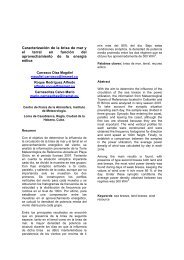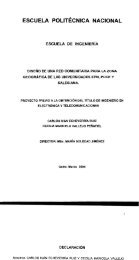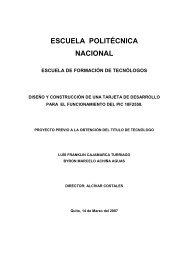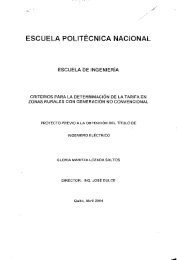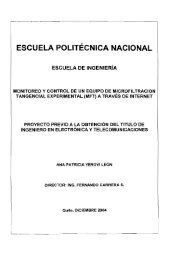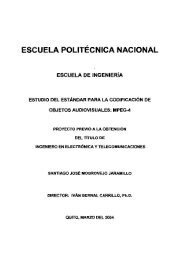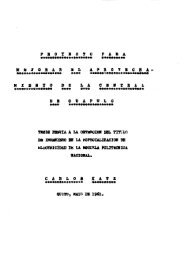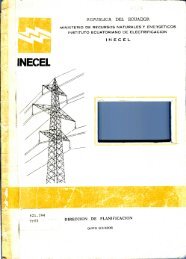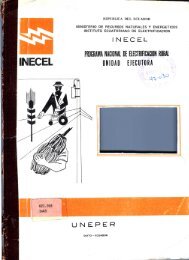Tesis previa a la obtención del Título de Ingeniero en Electrónica y ...
Tesis previa a la obtención del Título de Ingeniero en Electrónica y ...
Tesis previa a la obtención del Título de Ingeniero en Electrónica y ...
Create successful ePaper yourself
Turn your PDF publications into a flip-book with our unique Google optimized e-Paper software.
To <strong>en</strong>sure that the picture builds up quickly wh<strong>en</strong> the vi<strong>de</strong>o transmíssion first begins, the <strong>en</strong>co<strong>de</strong>r should<br />
transmit in INTRA mo<strong>de</strong> (see Recomm<strong>en</strong>dation H.261).<br />
Since thís INTRA can be received completely oníy if the remote <strong>de</strong>co<strong>de</strong>r ís ready, the <strong>en</strong>co<strong>de</strong>r should<br />
estímate wh<strong>en</strong> it should start INTRA. One way may be to repeat INTRA appropríate times or s<strong>en</strong>d<br />
Fill bits (<strong>de</strong>fined in 5.4.3/H.261) before s<strong>en</strong>ding INTRA. Another way may be that the <strong>de</strong>co<strong>de</strong>r estimates<br />
wh<strong>en</strong> the remote <strong>en</strong>co<strong>de</strong>r is ready and issues a VCU command at an appropriate timing.<br />
c) Fixed rate LSD/MLP cannot p<strong>en</strong>étrate into audio bitpositions ñor into fixed rate MLP/LSD bit positions.<br />
It can expand íts capacity into vacant or ví<strong>de</strong>o or variable MLP/LSD bit positions. It can reduce its<br />
capacity within the data bit positions curr<strong>en</strong>tly occupied. As a combination, fixed rate LSD/MLP can<br />
occupy new bit positions which have previously be<strong>en</strong> either vacant, vi<strong>de</strong>o, variable rate MLP/LSD or<br />
occupied by the same type of fixed rate data.<br />
d) Variable rate LSD/MLP occupies all bit positions which are not assigned by other fixed rate commands<br />
(ECS, audio, fixed rate MLP/LSD). If vi<strong>de</strong>o has be<strong>en</strong> on, it is exclu<strong>de</strong>d wh<strong>en</strong> variable rate LSD or MLP<br />
is turned on. If variable rate LSD/MLP has be<strong>en</strong> on, op<strong>en</strong>ing a variable rate MLP/LSD channel should be<br />
prece<strong>de</strong>d by closing the existing variable rate LSD/MLP channel.<br />
Variable rate LSD or MLP can be turned on at any time ev<strong>en</strong> if the avai<strong>la</strong>ble capacity for it is zero at the<br />
corresponding sub-multíframe; (it may happ<strong>en</strong>, for example, that the variable MLP is switched on just<br />
before closing the LSD channel which has be<strong>en</strong> occupying all the capacity other than audio); the <strong>de</strong>co<strong>de</strong>r<br />
must not ignore "variable rate LSD or MLP on" ev<strong>en</strong> in this case, otherwise a mo<strong>de</strong> mismatch occurs.<br />
e) LSD/MLP rate may be changed without first closing the data channel — this applies equally to changes<br />
betwe<strong>en</strong> fixed and variable rate. It is emphasized that there can only be one LSD and one MLP channel<br />
at any mstant.<br />
f) Capacity of ví<strong>de</strong>o or variable LSD/MLP can be temporarily reduced to zero in a sub-multíframe as part of<br />
dynamíc bit rate allocations. It is ¡mpractical, however, if that sítuation continúes for a long time.<br />
g) The rules for the use of HSD and H-MLP (in other than the I-channel) are i<strong>de</strong>ntical to those giv<strong>en</strong> above<br />
for LSD and MLP in the I-channel.<br />
h) Any co<strong>de</strong> can be s<strong>en</strong>t in bit positions which have not yet be<strong>en</strong> op<strong>en</strong>ed by the BAS commands, In a 2B<br />
communication, for example, the additional channel may s<strong>en</strong>d "O" or "1" or any combinations in bit<br />
positions except those for FAS and BAS till a 2B transfer rate command Ís s<strong>en</strong>t. It should be noted that<br />
although the terminal may set the "unop<strong>en</strong>ed" bits to any valúes, there is no assurance that those bits wíll<br />
be <strong><strong>de</strong>l</strong>ívered to other termináis in a multipoint confer<strong>en</strong>ce by the MCU.<br />
L3 Procedure for <strong>de</strong>aling with 6B-H0 interconnection<br />
por further study.<br />
L4 Procedure for use of <strong>en</strong>cryption control signal channel<br />
Each terminal must transmit the <strong>en</strong>cryption capabilhy co<strong>de</strong> if il Ís able to handle the ECS channel. No terminal may<br />
ictivate the channel without first receiving the corresponding capabílity co<strong>de</strong>. Once an ECS capability co<strong>de</strong> has be<strong>en</strong><br />
iransmitted it cannot be cancelled by omission from a subsequ<strong>en</strong>t capability exchange. That is to say, a terminal having<br />
anee received, stored and ma<strong>de</strong> use of an ECS capability co<strong>de</strong> should assume continued valídity until cancelled by the<br />
[ocal user. Thus <strong>en</strong>cryption can be discontinued by the users themselves but not by a third party tampering with<br />
the BAS-capability exchange,<br />
The initiating terminal transmits the command "ECS channel ON"; from the next multiframe it op<strong>en</strong>s the 800 bit/s<br />
ECS channel <strong>de</strong>fined in /Recomm<strong>en</strong>dation H.221, whose use is specified in the Recomm<strong>en</strong>dation <strong>de</strong>fining the<br />
sncryption system (FAS, BAS and the ECS channel itself are in any case not <strong>en</strong>crypled).<br />
V/h<strong>en</strong> <strong>en</strong>cryption has be<strong>en</strong> turned off, the BAS command "ECS channel OFF" is used ío cióse the ECS channel.



